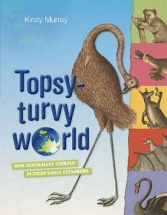Topsy-turvy world by Kirsty Murray

National Library of Australia, 2012. ISBN 978 0 642 27749 7.
(Ages: 10+) Recommended. Non fiction. Australian animals. Subtitled,
How
Australian animals puzzled early explorers, this attractively
produced
large non fiction book will amaze and intrigue readers as they look
inside its pages. Not only do they see pictures of animals drawn by
the
earliest explorers and their illustrators, but they have
descriptions
taken from their journals, ready for the reading market back in
Europe.
Europeans were fascinated by stories from unknown lands and read
journals and books about explorations and discoveries with fervour.
Each of the animals is given between four and six pages, the ones
that
caused the most controversy having the larger number of pages
allocated. Each section begins with a full page portrait, usually
done
by an artist who accompanied the expeditions. Following this is a
page
of information, then two or more pages giving more illustrations and
information, including a fact file and small map. The fifteen
animals included range from the expected kangaroo, thylacine and
platypus to the lesser known bandicoot, flying fox and sea dragon.
Several were of exceptional interest to me and a perusal of the
information given gives an idea of the sort of things included for
all
the other animals.
The pig-footed bandicoot was fist journalled by the explorer Thomas
Mitchell in 1836. He described this lovely little animal as
pig-footed, the size of a young wild rabbit and with a backward
facing
pouch. He asked local people for examples but was unable to add to
his
information. The drawings done by naturalists show a strange long
eared
creature the shape of a small pig with a snout, all rather at odds
with
the photo of the stuffed example found in a museum. But before
scientists could properly examine this new creature it had died out,
probably through the arrival of cattle. It used to frequent poor
land,
and so a common expression in the nineteenth century was the term,
bandicoot run, used to describe a strip of poor land.
I found each of the four pages devoted to this small animal,
enthralling, as I would expect many readers would, who like to
follow
up examples of Australian animals, and the way they were first seen
by
Europeans.
This book would be well used in classes looking at the early history
of
Australia, the history of European settlement, the story of the
animals, and particularly the extinction of several species covered
in
this book, the thylacine and the pig-footed bandicoot.
A detailed index, a glossary of the people who first noted and drew
these animals, along with glossary of terms and lists of where the
illustrations came from, complete this inviting book.
Fran Knight